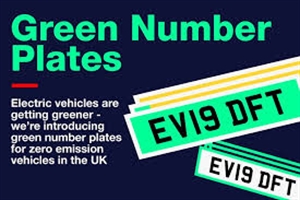Government consultation on introduction of 'green' number plates closes on 14 Jan
Tue 17 December 2019
View all news

The Government consultation about introducing green number plates "to celebrate and encourage uptake of electric vehicles" will close on 14 January 2020. The Government says that 'green' licence plates mean that the cleanest cars will be easily identifiable, helping their drivers to benefit from local incentives such as free or cheaper parking or even preferential access to some road areas.
Through the introduction of green number plates, local authorities would have a useful visual identifier should they wish to introduce incentives to promote the use of zero emission vehicles, such as allowing these drivers to use bus lanes and to pay less for parking. A similar scheme was trialled in Ontario with drivers of electric vehicles given free access to toll lanes and high occupancy vehicle lanes. Ontario saw an increase in electric vehicle registrations.
Transport Secretary Grant Shapps said: "Green number plates are a really positive and exciting way to help everyone recognise the increasing number of electric vehicles on our roads.
By increasing awareness of these vehicles and the benefits they bring to their drivers and our environment, we will turbo-charge the zero emission revolution."
Elisabeth Costa, Senior Director at the Behavioural Insights Team, said: "The number of clean vehicles on our roads is increasing but we don’t notice as it’s difficult to tell clean vehicles apart from more polluting ones.
"Green number plates make these vehicles, and our decision to drive in a more environmentally-friendly way, more visible on roads. We think making the changing social norm noticeable will help encourage more of us to swap our cars for cleaner options."
Potential plate designs include (see this link for images):
-
a fully green number plate with black lettering
-
the addition of a green flash on the plate
-
the addition of a green dot or symbol
The consultation follows the announcements at the 2018 ZEV summit and the Government’s Future of Mobility Grand Challenge and Road to Zero transport strategy, also published in 2018.
LowCVP's Managing Director, Andy Eastlake, commenting on the initiative said: "The number plate is a very good visual identifier; it's much easier to see than a vehicle sticker, is on both the front and back of the vehicle and, legally of course, it has to be prominently visible.
"The introduction of green number plates could be a powerful way to monitor and support incentives for the uptake of low emission vehicles through local initiatives and would also provide the potential for a consistent approach to be adopted across authorities.
"There are a lot of important questions to be answered, however, in terms of which vehicles should be eligible for the green plates and the range of vehicles to be included in the scheme. (For example, we already have a range of ultra low emission buses and standards for trucks will be emerging too.) Anything that helps demonstrate that ULEVs are becoming the most intelligent choice for many drivers and operators should, in my view, be encouraged."
LowCVP will be responding to the consultation and encourages members to make their own submissions.
Related Links
< Back to news list